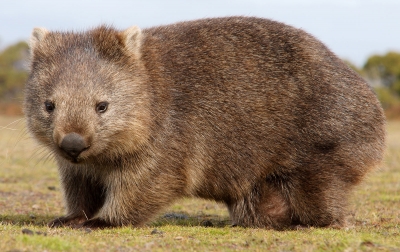
Odd-looking, but cuddly
The pudgy and furry wombat is one of the oddest-looking animals on Earth – rather like a pig, bear and koala all rolled into one.
There are three species of wombat: the common wombat (Vombatus ursinus), the northern hairy-nosed wombat (Laisorhinus krefftii), and the Southern hairy nosed wombat (Lasiorhinus latifrons). You will be able to see all three in Australia and Tasmania, usually in forested and mountainous area.
Marsupial
Wombats are marsupials, related to koalas and kangaroos. They usually live up to 15 years in the wild, but can live past 20 and even 30 years in captivity. Rotund, with stubby tails, short ears and tiny eyes, wombats grow to around one metre in length and weigh anything between 20 and 40 kg. their fur is either sandy brown or grayish-black and this helps them blend with the landscape – a way of safeguarding themselves from predators.
Big eaters
These animals are nocturnal and emerge from their burrows to feed at night. Being herbivores, they feed on grasses, herbs, bark, and roots. They spend a lot of time, eating. They have sharp large incisors like rodents which help them gnaw at thick vegetation. Their teeth never stop growing. But they are slow to digest their meal – it takes around 8-14 days for them to fully digest their food. But this helps them adapt to Australia’s arid conditions. Since they derive most of the moisture they require from plants, they don’t need to drink much water either. And interestingly, they are the only creatures in the world to excrete poop that is cube-shaped!
Burrowing away!
They are amazing burrowers and dig lengthy burrow systems with their razor-sharp teeth and claws. Common wombats are shy and solitary and inhabit their own burrows, while the other two species may be more social and live together in large groups in their warren.
Quick sprinters
Wombats may look plump and slow, in fact, their walk is more of a waddle. Despite their podgy bodies and stubby feet, they can run really fast – even up to 40 km/h.
Just communicate
They communicate with one another in various ways – vocalizations, aggressive displays, and markings on logs and branches made by rubbing against them repeatedly. Wombats tend to be more vocal during mating season. When angered, they can make hissing sounds.
Jellybean or joey?
Female wombats give birth to a single young one known as a joey in the spring, after a gestation period of 20-21 days. When the joey is born, it is the size of a jellybean and not completely developed. The joey climbs into it mother’s pouch right after birth to finish developing and stays there for about five to six months. Wombats are weaned after 15 months.
Once pests, now protected
In 1906, the Australian government declared wombats pests and encouraged people to kill them. From 1925 to 1965, some 63,000 wombats skins were redeemed for cash. Fortunately, this practice has stopped. All species of wombats are protected in every state except for Victoria.
Powerful posterior
Startled wombats can charge humans and bowl them over, with the risk of broken bones from the fall, besides wounds from bites and claws. When running away from predators like Tasmanian devils and dingos, wombats rely on their thick rump skin to protect them. Their rear-ends are mostly made up of cartilage, which makes them more resistant to bites and scratches. At the end of a chase, wombats will dive into their burrows and block the entrance with their posterior. They’re also capable of using their powerful backs to crush intruders against the roofs of their burrows.
Wombat facts
- A group of wombats is known as wisdom, a mob, or a colony.
- Believe it or not, wombats can jump! Some have been known to jump over metre-high fences.
- The giant wombat, an ancestor of modern-day wombats, lived during the Ice Age and was the size of a rhinoceros.
- Since 2005, Wombat Day is observed in Australia on October 22.
- Wombats have featured in Australian postage stamps and coins and ‘Fatso’, the wombat, was the unofficial mascot of the Sydney 2000 Summer Games.
Picture Credit : Google

